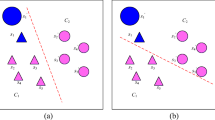Abstract
In this paper, an issue of building the RRC model using probability distributions other than beta distribution is addressed. More precisely, in this paper, we propose to build the RRR model using the truncated normal distribution. Heuristic procedures for expected value and the variance of the truncated-normal distribution are also proposed. The proposed approach is tested using SCM-based model for testing the consequences of applying the truncated normal distribution in the RRC model. The experimental evaluation is performed using four different base classifiers and seven quality measures. The results showed that the proposed approach is comparable to the RRC model built using beta distribution. What is more, for some base classifiers, the truncated-normal-based SCM algorithm turned out to be better at discovering objects coming from minority classes.
Access this chapter
Tax calculation will be finalised at checkout
Purchases are for personal use only
Similar content being viewed by others
References
Berger JO (1985) Statistical decision theory and Bayesian analysis. Springer, New York. https://doi.org/10.1007/978-1-4757-4286-2
Bergmann B, Hommel G (1988) Improvements of general multiple test procedures for redundant systems of hypotheses. In: Multiple hypothesenprüfung/multiple hypotheses testing. Springer, Heidelberg, pp 100–115.
Breiman L (1996) Bagging predictors. Mach Learn 24(2):123–140. https://doi.org/10.1007/bf00058655
Cover T, Hart P (1967) Nearest neighbor pattern classification. IEEE Trans Inform Theory 13(1):21–27. https://doi.org/10.1109/tit.1967.1053964
David HA, Nagaraja HN (2003) Order Statistics. Wiley, Hoboken. https://doi.org/10.1002/0471722162
Demšar J (2006) Statistical comparisons of classifiers over multiple data sets. J Mach Learn Res 7:1–30
Freund Y, Schapire RE (1997) A decision-theoretic generalization of on-line learning and an application to boosting. J Comput Syst Sci 55(1):119–139. https://doi.org/10.1006/jcss.1997.1504
Friedman M (1940) A comparison of alternative tests of significance for the problem of \(m\) rankings. Ann Math Stat 11(1):86–92. https://doi.org/10.1214/aoms/1177731944
Garcia S, Herrera F (2008) An extension on “statistical comparisons of classifiers over multiple data sets” for all pairwise comparisons. J Mach Learn Res 9:2677–2694
Hall M, Frank E, Holmes G, Pfahringer B, Reutemann P, Witten IH (2009) The WEKA data mining software. SIGKDD Explor Newsl 11(1):10. https://doi.org/10.1145/1656274.1656278
Hall, M.A.: Correlation-based feature selection for machine learning. Ph.D. thesis, The University of Waikato (1999)
Hand DJ, Yu K (2001) Idiot’s bayes: not so stupid after all? Int Stat Rev/Revue Internationale de Statistique 69(3):385. https://doi.org/10.2307/1403452
Johnson N (1994) Continuous Univariate Distributions. Wiley, New York
Kuncheva L, Bezdek J (1998) Nearest prototype classification: clustering, genetic algorithms, or random search? IEEE Trans Syst Man Cybern Part C (Appl Rev) 28(1):160–164. https://doi.org/10.1109/5326.661099
Kurzynski M, Majak M (2016) Meta-bayes classifier with Markov model applied to the control of bioprosthetic hand. In: Intelligent decision technologies 2016: proceedings of the 8th KES international conference on intelligent decision technologies (KES-IDT 2016) – part II. Springer, Cham, pp 107–117
Kurzynski M, Majak M, Zolnierek A (2016) Multiclassifier systems applied to the computer-aided sequential medical diagnosis. J Biocybern Biomed Eng 36:619–625
Lysiak R, Kurzynski M, Woloszynski T (2014) Optimal selection of ensemble classifiers using measures of competence and diversity of base classifiers. Neurocomputing 126:29–35. https://doi.org/10.1016/j.neucom.2013.01.052
Majak M, Kurzynski M (2018) On a new method for improving weak classifiers using bayes metaclassifier. In: Proceedings of the 10th international conference on computer recognition systems, CORES 2017. Springer, Cham, pp 258–267.
Provost F, Domingos P (2003) Tree induction for probability-based ranking. Mach Learn 52(3):199–215. https://doi.org/10.1023/a:1024099825458
Quinlan JR (1993) C4.5: programs for machine learning. Morgan Kaufmann Publishers Inc., San Francisco
Sokolova M, Lapalme G (2009) A systematic analysis of performance measures for classification tasks. Inf Process Manag 45(4). https://doi.org/10.1016/j.ipm.2009.03.002
Trajdos P, Kurzynski M (2016) A dynamic model of classifier competence based on the local fuzzy confusion matrix and the random reference classifier. Int J Appl Math Comput Sci 26(1). https://doi.org/10.1515/amcs-2016-0012
Wilcoxon F (1945) Individual comparisons by ranking methods. Biometrics Bull 1(6):80. https://doi.org/10.2307/3001968
Woloszynski T, Kurzynski M (2009) On a new measure of classifier competence applied to the design of multiclassifier systems. In: International conference on image analysis and processing. Springer, pp 995–1004
Woloszynski T, Kurzynski M (2011) A probabilistic model of classifier competence for dynamic ensemble selection. Pattern Recogn 44(10–11):2656–2668. https://doi.org/10.1016/j.patcog.2011.03.020
Yekutieli D, Benjamini Y (2001) The control of the false discovery rate in multiple testing under dependency. Ann Stat 29(4):1165–1188. https://doi.org/10.1214/aos/1013699998
Acknowledgments
This work was supported by the statutory funds of the Department of Systems and Computer Networks, Wroclaw University of Science and Technology.
Author information
Authors and Affiliations
Corresponding author
Editor information
Editors and Affiliations
Rights and permissions
Copyright information
© 2020 Springer Nature Switzerland AG
About this paper
Cite this paper
Trajdos, P., Kurzynski, M. (2020). Randomized Reference Classifier with Gaussian Distribution and Soft Confusion Matrix Applied to the Improving Weak Classifiers. In: Burduk, R., Kurzynski, M., Wozniak, M. (eds) Progress in Computer Recognition Systems. CORES 2019. Advances in Intelligent Systems and Computing, vol 977. Springer, Cham. https://doi.org/10.1007/978-3-030-19738-4_33
Download citation
DOI: https://doi.org/10.1007/978-3-030-19738-4_33
Published:
Publisher Name: Springer, Cham
Print ISBN: 978-3-030-19737-7
Online ISBN: 978-3-030-19738-4
eBook Packages: Intelligent Technologies and RoboticsIntelligent Technologies and Robotics (R0)




